Copper: First Metal Used By Ancient Man More Than 10,000 Years Ago
A. Sutherland - AncientPages.com - Copper was used by several ancient civilizations for a number of reasons. It was the first metal ever used by ancient man, dating back more than 10,000 years.
Ancient Egyptians considered copper to be a sacred metal and they believed it gave magical powers to those who wore it.
There is disagreement among archaeologists about the exact date and location of the first utilization of copper by humans.
The Imdugud Relief. Copper alloy relief on bitumen of lion-headed eagle Imdugud gripping the haunches of two stags. Image credit: British Museum
The Sumerians and Chaldeans of Mesopotamia developed considerable skill in fabricating copper and from these centers, the rudiments of craftsmanship spread to the river-dwelling people of Egypt, where it continued to flourish for thousands of years long after their own civilization had degenerated.
Copper comes from the Latin word cuprum, meaning “from the island of Cyprus,” but it is not on this island that we find the most ancient evidence of the use of copper.
The oldest copper artifact ever discovered was unearthed in Tel Tsaf, an archaeological site in Israel located near the Jordan River and Israel's border with Jordan. The area was a village from about 5100 B.C. to 4600 B.C.
A copper awl was discovered at the archaeological site Tel Tsaf in the Jordan Valley of Israel, dating to 5100 B.C. to 4600 B.C. Credit: PLOS ONE, doi: 10.1371/journal.pone.0096882
The cone-shaped copper awl was found in the grave of a woman who was about 40 years old when she died, and who had a belt around her waist made of 1,668 ostrich-egg shell beads.
This ancient copper object provides evidence that metals were exchanged across hundreds of miles in this region more than 6,000 years ago, centuries earlier than previously thought.
Ancient copper plate.
Around 8,000 and 5,000 B.C. the knowledge and use of copper were spread in the regions known now as Turkey, Iran, Iraq, and toward the end of that period we also find traces of copper used on the Indian subcontinent. Archaeologists have also found evidence of mining and annealing of the abundant native copper in the Upper Peninsula of Michigan in the United States dating back to 5,000 B.C.
The Egyptians mined copper from Sinai and used it mostly to produce agricultural tools. Of course, the ancient Egyptians were also rather vain and famously fond of personal beautification. Therefore they manufactured mirrors and razors out of copper and produced green and blue makeup from malachite and azurite, two copper compounds with brilliant green and blue colors.
The ancient Qijia Culture that mysterious disappeared also produced some of the earliest copper mirrors.
Sumerians on the other hand were masters of sculpture and they created some of the most beautiful ancient copper artifacts. As one example, we can mention the magnificent Imdugud Relief which represents a lion-headed eagle holding two stags by their tails.
In time, ancient civilizations understood copper could be used for other means than producing artifacts. The medical use of copper has origins in prehistoric civilizations.
Ancient Egyptians started using copper to sterilize water and wounds around 2,400 B.C, and, by 1,500 B.C., they also used the mineral on burns and itching, and to ease the pain of headaches. In ancient India, copper was used for medical equipment including surgical instruments.
The creation of copper coins came as the next development. Around 3,200 B.C, ancient Egyptian began to utilize copper to create balances and weights used in trade and religious ceremonies. The Assyrians followed up on this idea and used lion weights marked with the names of kings. In ancient China, weights were also made in the shape of animals.
Copper played also a vital role in ancient rituals, ceremonies, and spiritual beliefs. Hathor, the ancient Egyptian goddess of the sky, music, dance, and art, was also the patron of Sinai, the major copper mining region of the Egyptians. She was often referred to as “Lady of Malachite.” In South America, people of the Andes produced a variety of religious items from pounded copper foil and gilded copper.
In many pre-colonial sub-Saharan cultures as well, coppersmiths were believed to have powers as shamans, magicians, and priests because of their intimate knowledge of earth, minerals, and fire and their ability to produce metal from ore. In some parts of the continent coppersmithing was an inherited position with master smiths passing secret knowledge on to their sons. Mining, smelting, and casting of copper ore were preceded by elaborate ceremonies to ensure that the endeavors were safe and fruitful.
So, the history of copper goes far back in time.
Written by – A. Sutherland - AncientPages.com Senior Staff Writer
Copyright © AncientPages.com All rights reserved. This material may not be published, broadcast, rewritten or redistributed in whole or part without the express written permission of AncientPages.com
Expand for referencesMore From Ancient Pages
-
 The Apaches’ Mysterious Encounter With Unknown Beings
Featured Stories | Jun 10, 2024
The Apaches’ Mysterious Encounter With Unknown Beings
Featured Stories | Jun 10, 2024 -
 DNA Analysis Of Human Remains In Early Medieval Alemannic Graveyard
Archaeology | Sep 6, 2018
DNA Analysis Of Human Remains In Early Medieval Alemannic Graveyard
Archaeology | Sep 6, 2018 -
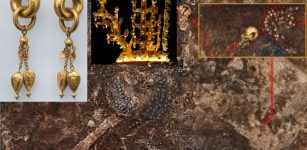 South Korea’s Silla-Era Tombs Reveal More Priceless Jewelry
Archaeology | Sep 9, 2020
South Korea’s Silla-Era Tombs Reveal More Priceless Jewelry
Archaeology | Sep 9, 2020 -
 Who Was The Mysterious Spitalfields Roman Noblewoman Dressed In Silk Found In A Sarcophagus In London?
Archaeology | Dec 21, 2020
Who Was The Mysterious Spitalfields Roman Noblewoman Dressed In Silk Found In A Sarcophagus In London?
Archaeology | Dec 21, 2020 -
 Odd Ancient Dwellings Of The Snake People – American-European Connection Part 1
Featured Stories | Sep 6, 2020
Odd Ancient Dwellings Of The Snake People – American-European Connection Part 1
Featured Stories | Sep 6, 2020 -
 Those Who Mysteriously Disappeared To A World Beyond Human Understanding
Featured Stories | Apr 30, 2019
Those Who Mysteriously Disappeared To A World Beyond Human Understanding
Featured Stories | Apr 30, 2019 -
 4,700 ‘Forest Islands’ Created By Amazon’s Earliest Humans
Archaeology | Apr 15, 2020
4,700 ‘Forest Islands’ Created By Amazon’s Earliest Humans
Archaeology | Apr 15, 2020 -
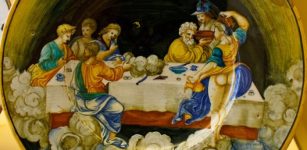 Amrita: Potion Of Immortality Consumed By Gods To Make Them Strong And Immortal
Featured Stories | Apr 5, 2019
Amrita: Potion Of Immortality Consumed By Gods To Make Them Strong And Immortal
Featured Stories | Apr 5, 2019 -
 Beautiful Legend Of Giant Olentzero Who Brings Christmas Presents To Basque Children
Ancient Traditions And Customs | Dec 19, 2020
Beautiful Legend Of Giant Olentzero Who Brings Christmas Presents To Basque Children
Ancient Traditions And Customs | Dec 19, 2020 -
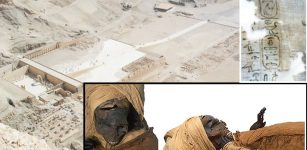 King Seqenenre Taa II Was Killed By Hyksos Invaders – Mummy Scans Reveal His Wounds
Archaeology | Feb 17, 2021
King Seqenenre Taa II Was Killed By Hyksos Invaders – Mummy Scans Reveal His Wounds
Archaeology | Feb 17, 2021 -
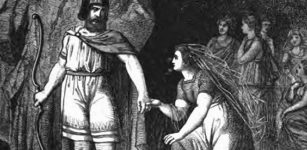 Freya And Her Lovely Husband Odr, God Of Summer Sun And Passion In Norse Mythology
Featured Stories | Dec 3, 2018
Freya And Her Lovely Husband Odr, God Of Summer Sun And Passion In Norse Mythology
Featured Stories | Dec 3, 2018 -
 Unique Gold Votive Plaque Found At Fort Apsaros Reveals Evidence Of A Mysterious Roman Sect
Archaeology | Nov 14, 2024
Unique Gold Votive Plaque Found At Fort Apsaros Reveals Evidence Of A Mysterious Roman Sect
Archaeology | Nov 14, 2024 -
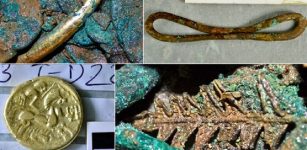 Remarkable Le Catillon II Hoard – World’s Largest Collection Of Celtic Coins And Jewellery
Archaeology | Nov 24, 2015
Remarkable Le Catillon II Hoard – World’s Largest Collection Of Celtic Coins And Jewellery
Archaeology | Nov 24, 2015 -
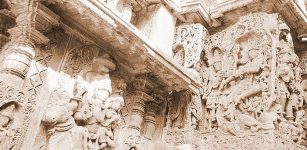 Hoysaleswara Temple: Great Supporter Of Most Powerful Traditions Of Hinduism
Featured Stories | Jun 21, 2021
Hoysaleswara Temple: Great Supporter Of Most Powerful Traditions Of Hinduism
Featured Stories | Jun 21, 2021 -
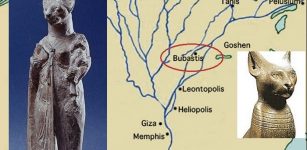 Bastet: Protector And Punisher – She Was Among The Most Majestic Egyptian Deities
Egyptian Mythology | Jun 21, 2019
Bastet: Protector And Punisher – She Was Among The Most Majestic Egyptian Deities
Egyptian Mythology | Jun 21, 2019 -
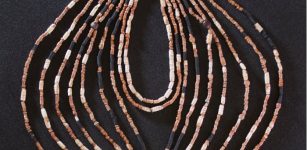 Beautiful Neolithic Ornate Necklace With Over 2,500 Stones Found In A Child’s Grave
Archaeology | Aug 2, 2023
Beautiful Neolithic Ornate Necklace With Over 2,500 Stones Found In A Child’s Grave
Archaeology | Aug 2, 2023 -
 Migration Of Early Humans Out Of Africa Began Thousands Of Years Earlier Than Previously Thought
Archaeology | Dec 18, 2017
Migration Of Early Humans Out Of Africa Began Thousands Of Years Earlier Than Previously Thought
Archaeology | Dec 18, 2017 -
 Spells And Magic Were Important To Samurai Warriors And Used In Battles
Featured Stories | Oct 7, 2017
Spells And Magic Were Important To Samurai Warriors And Used In Battles
Featured Stories | Oct 7, 2017 -
 Are The Strange Lawrence Brook Carvings In New Jersey A Cryptic Message?
Featured Stories | Feb 10, 2023
Are The Strange Lawrence Brook Carvings In New Jersey A Cryptic Message?
Featured Stories | Feb 10, 2023 -
 Biblical Prophet Jeremiah Whose Prophecies Disappointed People
Biblical Mysteries | Jan 30, 2019
Biblical Prophet Jeremiah Whose Prophecies Disappointed People
Biblical Mysteries | Jan 30, 2019



